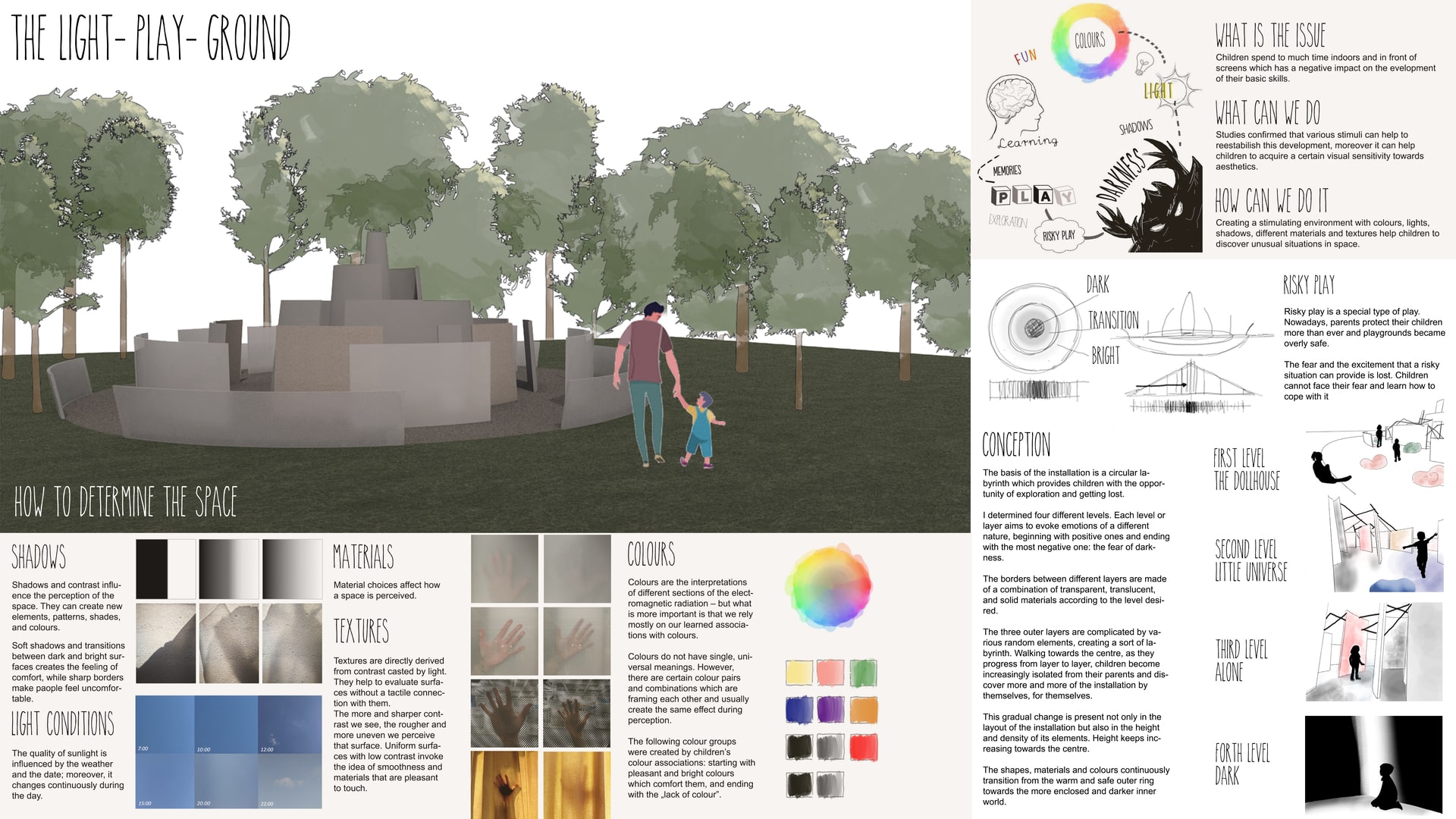Project Description
Children are susceptible to acquire new knowledge and learn at a rapid pace. In connection with light, they learn the difference between opaque and transparent materials during the first few years of their lives. After the age of three, they explore shadows and learn about the danger of staring directly at the sun. Later, at the age of six, they begin to comprehend how light travels, understand correlations between shapes and shadows, and explore reflections. The more stimuli they receive during these years, the better their visual sensitivity develops, promoting their creativity and sense of aesthetics. Nowadays, children spend way too much time in front of screens, hindering the development of basic visual skills. Moreover, kids spend most of their time indoors. Indoors spaces provide a confined environment and many rules: take off your shoes, stop jumping on the bed, the list is endless. Rules limit the range of possible activities children can do inside, therefore also limiting their creativity. Playgrounds have special significance in children’s development: there, no preconceived ideas and strict rules about playing exist. At the same time, playgrounds provide safe spaces where kids make new friends, learn to interact with each other and to play together. They gain confidence and become more independent. In childhood, playing is the best way to acquire new information and learn. Although defined as a spontaneous or organized activity that provides enjoyment, entertainment, amusement or diversion, playing is also a very serious business for children. Playgrounds and other environments are – understandably – becoming more and more safe for children. The process of learning, however, often requires an element of risk; this makes the experience more exciting, and therefore more memorable. Risky play provides a great opportunity for children to challenge themselves, testing their limits. Moreover, experiencing negative emotions in a relatively safe, friendly environment induces confidence, preventing the development of phobias and anxiety. In childhood, night-time fear – most often in close connection with darkness – is a common experience, increasing the future risks for major depression. Therefore, it is important to assist children while they experience darkness and help them cope with their fear. My aim was to create an exciting light-colour-space experience for preschool-aged children in an outdoors environment: a playground installation where kids can meet various stimuli, different atmospheres, and scenarios that they do not know from everyday situations. My tools for this were light, shadows and darkness, various colours and forms as well as the space they define. The main motive of the installation is a circular labyrinth in which new experiences, colours, forms, atmospheres, and emotions reveal themselves as one proceeds towards the centre. The aim of this arrangement is to enable children to step out of the safety provided by the vicinity of their parents, and explore the space on their own, finally reaching the centre. Abstract forms help the development of imagination and enable a wide range of stories and games to play out. At different times of the day or under different weather and light conditions, the installation offers different looks of the same familiar spaces. The shapes, materials and colours continuously transition from the warm and safe outer ring towards the more enclosed and darker inner world. The developing tension is dissolved by familiar colours and shapes that help getting used to new and foreign spaces. In the innermost part of the labyrinth, the bravest can experience almost complete darkness. Dollhouse In the outermost ring, elements of the labyrinth are small and consist of smooth, curved shapes. Children and parents can see and interact with each other. Colours suggest a safe and welcoming environment, while transparent elements provide children with the discovery of light transmission. Little Universe In the next layer, distinct forms, sharp shadows break the uniformity of soft surfaces. The height of wall elements increases, still enabling for parents to see their child, while the sight of children is more obstructed. Children can explore the space without assistance, but parents can control the situation. Alone (A “parent-free” zone) Sharp and distinct forms dominate the space. Children cannot see their parents, and parents cannot see them either. Colours and shadows trigger dramatic effects and create an exciting and scary atmosphere. Risky play takes place in this space. To offset the negative effects, small “windows” connect children to the outer layers where familiar colours and forms can be peeked at. Dark In the innermost layer, children are completely alone in a partially closed “tent”. The only light in this place is provided by the little openings on the top of the walls, creating a mysterious effect with the softly shaped walls. In the centre of the labyrinth, children meet darkness and build up their confidence by facing it.
